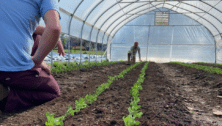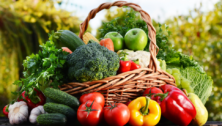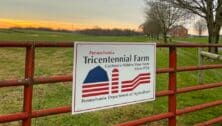Chester County Ag Notes: The World’s Mushroom Capital
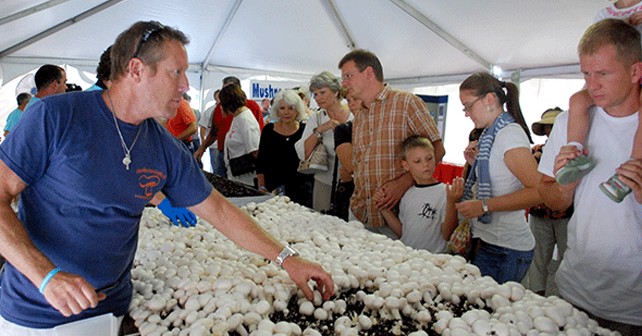
By Duncan Allison
Chester County’s reputation as The “Mushroom Capital of the World” came about in the 1890’s. Two Quaker greenhouse flower growers in Kennett Square found that mushrooms grew well in the wasted space under the benches on which their carnations were growing.
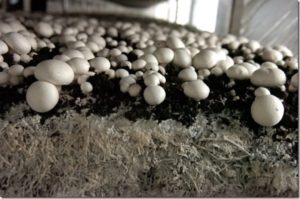 They had imported the spawn, the fungal “seed” for the cultivated white mushroom, from Europe and there was a plentiful local supply of the base growing material for the mushroom compost from the many horses that existed in this pre-automobile era. Mushrooms grew well in the dark and humid conditions.
They had imported the spawn, the fungal “seed” for the cultivated white mushroom, from Europe and there was a plentiful local supply of the base growing material for the mushroom compost from the many horses that existed in this pre-automobile era. Mushrooms grew well in the dark and humid conditions.
Soon these two growers were constructing special structures where the ideal conditions existed for mushroom culture –stable temperature, humidity and darkness. Soon other growers joined them. A local grower developed pure spawn that was even exported back to Europe.
The industry was born that over 120 years later supplies around 50% of all the mushrooms consumed in the US and contributes an estimated $2.17 billion to the local economy.
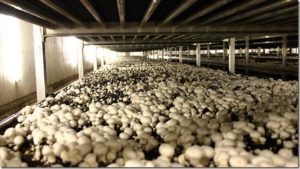 In 2015 mushrooms are grown by around 60 families in Chester County, many of them fourth generation. Production is year round and mushrooms grow so fast they must be hand-picked every single day to ensure top quality.
In 2015 mushrooms are grown by around 60 families in Chester County, many of them fourth generation. Production is year round and mushrooms grow so fast they must be hand-picked every single day to ensure top quality.
This requires a large, well-trained labor force to pick the mushrooms very early in the day so that they can be chilled and packed ready for shipment. Later in the same day large trucks depart for destinations throughout the country to deliver mushrooms to the major retail and food service chain distribution centers.
The growing medium or compost is produced in huge quantities from organic matter – hay, straw, horse and poultry manure and by-products from other agricultural industries. Some growers produce their own compost but others purchase compost from specialist producers.
Once the compost is placed in the beds it is “seeded” with the mushroom spawn supplied by one of the 6 spawn producers in the area. Careful control of temperature and moisture content allows the fungal mycelium to populate the compost and produce several flushes of mushrooms.
Fifty years ago mushroom growers produced 3lbs. of mushrooms per square foot but today growers are able to obtain yields of 7.5 lbs.
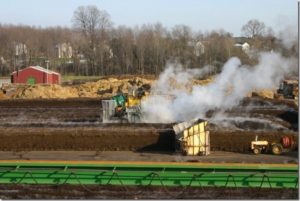 After the last good flush of mushrooms has been harvested, the houses and spent mushroom substrate (known as SMS) are steamed. The SMS is taken out and recycled in a wide range of uses on the land to ameliorate soil and for use in plant compost, green roofs and for many other uses.
After the last good flush of mushrooms has been harvested, the houses and spent mushroom substrate (known as SMS) are steamed. The SMS is taken out and recycled in a wide range of uses on the land to ameliorate soil and for use in plant compost, green roofs and for many other uses.
The mushroom crop is a perfect example of the interconnectedness of mushroom growers not only with the local farms which supply the hay, straw, horse and poultry manure but also the trucking, compost and packing companies, and the many HVAC and technical services required to keep the mushroom houses at the correct temperature, air quality and humidity throughout the crop cycle.
Further articles will review critical elements of this important crop such as the vital role of labor and need for immigration reform, food safety, value of research and development, range of mushroom types and trends in marketing.
_________
 Duncan Allison gained degrees in horticulture and extension education in the UK and US and spent most of his career working for the DuPont Company developing and marketing crop protection chemicals. Recently he has written reports for a global ag publisher and for New Jersey-based international business consultants Kline & Co. For the last 16 years he has been heavily involved in the local farming of Chester County where he has lived with his wife and family since 1980.
Duncan Allison gained degrees in horticulture and extension education in the UK and US and spent most of his career working for the DuPont Company developing and marketing crop protection chemicals. Recently he has written reports for a global ag publisher and for New Jersey-based international business consultants Kline & Co. For the last 16 years he has been heavily involved in the local farming of Chester County where he has lived with his wife and family since 1980.
Connect With Your Community
Subscribe to stay informed!
"*" indicates required fields


























![95000-1023_ACJ_BannerAd[1]](https://vista.today/wp-content/uploads/2023/03/95000-1023_ACJ_BannerAd1.jpg)


















